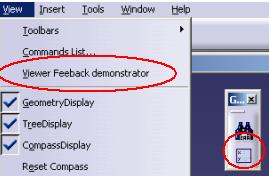
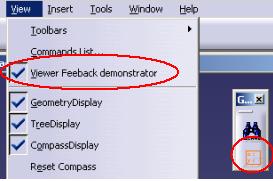
3D PLM Enterprise Architecture |
3D Visualization |
Viewer FeedbackHow to retrieve information on interactions coming from viewers |
| Use Case | ||
AbstractThis article shows how to retrieve and analyze information on interactions coming from viewers. These interactions can be mouse motion or press/release button. |
This use case is intended to show you how to retrieve and analyze information on interactions coming from viewers. You will learn how to:
[Top]
CAACafViewerFeedback is a use case of CAACATIAApplicationFrm.edu and CAAApplicationFrame.edu frameworks that illustrates Visualization framework capabilities.
[Top]
CAACafViewerFeedback use case enables you to activate or deactivate the feedback mode on the current viewer. This switch is possible thanks to a command set in an add-in of the General workshop [1].
The Viewer Feedback demonstrator command, see pictures below, is represented by a check button. When the button is "ON" (right picture), the feedback mode is active. When the button is "OFF" (left picture), the feedback mode is not active.
 |
 |
When the feedback mode is active in the current viewer you can see:
 |
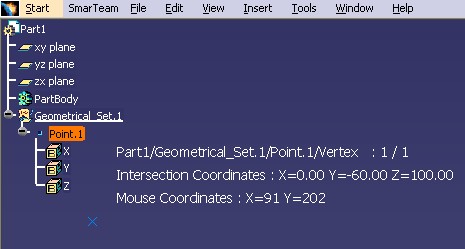 |
On this picture you can see that there is only one selected element.
[Top]
To launch CAACafViewerFeedback, you will need to set up the build time environment, then compile CAACafViewerFeedback along with its prerequisites, set up the run time environment, and then execute the use case [2].
But just before launching the execution, edit the CAAApplicationFrame.edu.dico interface dictionary file in the dictionary directory of your runtime view:
InstallRootDirectory\OS\code\dictionary\
where InstallRootDirectory is the directory where the CAA CD-ROM
is installed and OS is a directory the name of which depends on the operating
system. Refer to [2]
to get the list of the currently supported operating systems and their
associated directory names..
In this file, remove the "#" character before the two following lines:
... #CAAAfrGeneralWksAddin CATIWorkbenchAddin libCAAAfrGeneralWksAddin #CAAAfrGeneralWksAddin CATIAfrGeneralWksAddin libCAAAfrGeneralWksAddin ... |
The two line deal with the General workshop add-in described in the CAAAfrGeneralWksAddin use case [1] located in the CAAAfrGeneralWksAddin.m module (CAAApplicationFrame.edu framework)
Then, in the window where you run the mkrun command, do not type the module name on the command line, but type CNEXT instead. When the application is ready, do the following:
[Top]
The CAACafViewerFeedback use case is made of several classes located:
This module contains an add-in of the general workshop which defines a toolbar with the "Viewer Feedback Demonstrator" command. This part of the use case is not explained in this article. You can you refer to the add-in article [1] for more details.
| Windows | InstallRootDirectory\CAAApplicationFrame.edu\CAAAfrGeneralWksAddin.m\ |
| Unix | InstallRootDirectory/CAAApplicationFrame.edu/CAAAfrGeneralWksAddin.m/ |
This module contains CAACafViewerFeedbackManager and CAACafViewerFeedbackCmd classes.
| Windows | InstallRootDirectory\CAACATIAApplicationFrm.edu\CAACafViewerFeedback.m\ |
| Unix | InstallRootDirectory/CAACATIAApplicationFrm.edu/CAACafViewerFeedback.m/ |
Only one instance of the CAACafViewerFeedbackManager class is created during the session. This class manages the current viewer and the feedback mode on the current viewer. It means how to receive notifications sent by the viewer, and once received, how to decode it to display some information in the 2D Viewpoint of the viewer. The CAACafViewerFeedbackCmd command, explained in the "Creating a Command with Options in the "Tools Palette" Toolbar" article [3], informs the unique CAACafViewerFeedbackManager class instance to activate or deactivate the feedback mode.
where InstallRootDirectory is the directory where the CAA CD-ROM
is installed.
[Top]
There are four logical steps in the CAACafViewerFeedback use case:
[Top]
// System Framework
#include "CATBaseUnknown.h" // Needed to derive from
#include "CATEventSubscriber.h" // To set callback
class CAT2DBagRep ; // The graphic representation of the feedback
class CATViewer ; // The viewer with the visual feedback
class CATNotification ; // for callback methods
class CATUnicodeString ; //
class CATPathElement ; //
class CAACafViewerFeedbackManager : public CATBaseUnknown
{
public :
CAACafViewerFeedbackManager ();
virtual ~CAACafViewerFeedbackManager();
static void GetManager(CAACafViewerFeedbackManager ** opManager);
void SetViewerFeedbackOn();
void SetViewerFeedbackOff();
private :
void ViewerFeedbackCB (CATCallbackEvent iEventAlarm,
void *iAlarm,
CATNotification *iNotifAlarm,
CATSubscriberData iBurglarData,
CATCallback iCallBack );
void WindowActivatedCB (CATCallbackEvent iEventAlarm,
void *iAlarm,
CATNotification *iNotifAlarm,
CATSubscriberData iBurglarData,
CATCallback iCallBack );
void WindowDeactivatedCB (CATCallbackEvent iEventAlarm,
void *iAlarm,
CATNotification *iNotifAlarm,
CATSubscriberData iBurglarData,
CATCallback iCallBack );
void PathElementString(CATPathElement * ipPath,
CATUnicodeString & oPathName) ;
void ChangeBagPosition(float Xpos, float Ypos) ;
CAACafViewerFeedbackManager(const CAACafViewerFeedbackManager &iObjectToCopy);
CAACafViewerFeedbackManager & operator = (const CAACafViewerFeedbackManager &iObjectToCopy);
private :
CATViewer * _pCurrentViewer ;
CAT2DBagRep * _pInformationsToDisplay;
CATCallback _ViewerFeedbackCB ;
CATCallback _WindowActivatedCB ;
CATCallback _WindowDeactivatedCB ;
CATCallback _WindowDeletedCB ;
};
|
This class contains the following methods:
GetManager: it is a static method which manages
the singleton.SetViewerFeedbackOn: actives the feedback mode - see the Activating the Feedback Mode
sectionSetViewerFeedbackOff: deactivates the feedback mode - see the Deactivating the Feedback Mode
sectionViewerFeedbackCB: this method is a callback
method to analyze the CATVisViewerFeedback
notificationWindowActivatedCB and WindowDeactivatedCB: these two methods
are callback methods to manage window activation, deactivation and deletion.
The first one calls the SetViewerFeedbackOn method if the
feedback mode is active, and the second method calls the SetViewerFeedbackOff
method.PathElementString: It is a service to translate
in a string a CATPathElement. For each element of the path, the CATIAlias
interface is called.ChangeBagPosition: this method is also a service
to move the text near the mouse position. Click
here to see the code.and contains the following data:
pCurrentViewer: it is one viewer of the current
window._pInformationsToDisplay: it is the graphic representation which
groups together texts_ViewerFeedbackCB: it is the identifier of the viewer
callback._WindowxxxCB: there are the identifiers of the window
callbacks[Top]
The SetViewerFeedbackOn method consists in first to retrieve a
viewer:
void CAACafViewerFeedbackManager::SetViewerFeedbackOn()
{
if ( NULL == _pCurrentViewer )
{
CATFrmLayout * pCurrentLayout= CATFrmLayout::GetCurrentLayout();
if ( NULL != pCurrentLayout )
{
CATFrmWindow * pCurrentWindow = pCurrentLayout->GetCurrentWindow();
if ( NULL != pCurrentWindow )
{
_pCurrentViewer = pCurrentWindow->GetViewer();
...
|
This viewer is one of the current window (it is the choice of this command). The CATFrmLayout [4] is the class which manages all the windows all the session.
Then, once you have a viewer, you can activate the feedback mode:
...
if ( NULL != _pCurrentViewer )
{
_pCurrentViewer->SetFeedbackMode(TRUE);
if (0 == _ViewerFeedbackCB)
{
_ViewerFeedbackCB = ::AddCallback(this,
_pCurrentViewer,
CATViewer::VIEWER_FEEDBACK_UPDATE(),
(CATSubscriberMethod) & CAACafViewerFeedbackManager::ViewerFeedbackCB, NULL);
}
}
|
The SetFeedbackMode method with TRUE actives the
feedback mode. It means that now the viewer sends notifications when an
interaction occurs. To receive these notifications, the command sets a
callback.
this : the event subscriber_pCurrentViewer : the publisherCATViewer::VIEWER_FEEDBACK_UPDATE(): the dispatched
CATCallbackEvent [5]ViewerFeedbackCB: the callback method - See the Decoding the CATVisViewerFeedbackEvent Notification
sectionNULL: no argument_ViewerFeedbackCB is an identifier of the callback, it is
important to keep it for the callback deletion. See the SetViewerFeedbackOn method
[Top]
The SetViewerFeedbackOn method consists in to cancel the
feedback mode on the current viewer.
void CAACafViewerFeedbackManager::SetViewerFeedbackOff()
{
if ( NULL != _pCurrentViewer)
{
_pCurrentViewer->SetFeedbackMode(FALSE);
if (NULL != _pInformationsToDisplay)
{
_pCurrentViewer->RemoveRep(_pInformationsToDisplay);
_pInformationsToDisplay->Destroy();
_pInformationsToDisplay = NULL;
}
_pCurrentViewer->Draw();
if (0 != _ViewerFeedbackCB)
{
::RemoveCallback(this,_pCurrentViewer,_ViewerFeedbackCB) ;
_ViewerFeedbackCB = 0 ;
}
_pCurrentViewer = NULL ;
}
}
|
There are four steps:
SetFeedbackMode
method with FALSE as argument. It means that now the viewer will do not send
notifications when an interaction will occurs.ViewerFeedbackCB
method. _pInformationsToDisplay is first removed from the
viewer and then deleted. The Destroy method deletes the graphic
representation and its contents, if it is a bag.Draw method_ViewerFeedbackCB
is the identifier returns by the AddCallback method. See the SetViewerFeedbackOn method._pCurrentViewer, returned by the GetViewer
method of CATFrmWindow, is not "AddReffed" by this method,
so you have just to reset the pointer.[Top]
The ViewerFeedbackCB method consists in to decode the
notification contained in the callback event, and to display in the main 2D
viewpoint of the viewer, the information of the notification.
void CAACafViewerFeedbackManager::ViewerFeedbackCB( CATCallbackEvent event,
void * client,
CATNotification * iNotification,
CATSubscriberData data,
CATCallback callback)
{
if ( NULL != _pCurrentViewer )
{
if (NULL != _pInformationsToDisplay)
{
_pCurrentViewer->RemoveRep(_pInformationsToDisplay);
_pInformationsToDisplay->Destroy();
_pInformationsToDisplay = NULL;
}
...
|
The ViewerFeedbackCB method is called each time the viewer sends
an event. So the graphic representation, _pInformationsToDisplay,
previously created, should be first removed from the viewer and deleted.
CATVisViewerFeedbackEvent * pFeedbackEvent = NULL ;
if ( NULL != iNotification )
{
pFeedbackEvent = (CATVisViewerFeedbackEvent*) iNotification;
}
if (NULL != pFeedbackEvent)
{
CATViewer * pViewerPublisher = pFeedbackEvent->GetViewer();
if ( (NULL != pViewerPublisher) && ( pViewerPublisher == _pCurrentViewer) )
{
_pInformationsToDisplay = new CAT2DBagRep();
_pCurrentViewer->AddRep(_pInformationsToDisplay);
...
|
The third argument of the ViewerFeedbackCB method is the notification
containing the information. This notification, iNotification, is a CATVisViewerFeedbackEvent
class. This class instance contains the viewer which has published the
event. GetViewer retrieves it, it is pViewerPublisher.
This viewer should be released at this end of the method. This value enables you to check that
the current viewer, _pCurrentViewer, kept by the manager, is the
same as the notification's sender. Once the check is validated, a new
graphic representation can be built.
_pInformationsToDisplay is a 2D bag added to the viewer thanks
to the AddRep method. This method adds the 2D representation to the
main 2D viewpoint. _pInformationsToDisplay will have several children depending on the notification's contents.
The ViewerFeedbackCB method analyses and displays a text for :
These three steps are described below.
Before to detail the code, a picture to explain the screen coordinates:
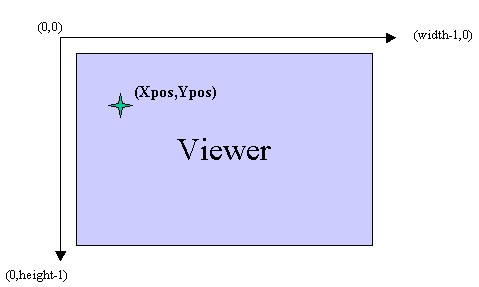 |
If (Xpos,Ypos) are the screen coordinates of the mouse,
where width and height are the support (CATSupport) dimensions. |
int XPos, YPos;
pFeedbackEvent->GetMousePosition(&XPos, &YPos);
ChangeBagPosition(XPos,YPos);
float points[2];
points[0] = 8.0f;
points[1] = 8.0f;
...
|
GetMousePosition returns the mouse position in screen
coordinates. This position serves to locate the 2D bag. The ChangeBagPosition
method locates _pInformationsToDisplay near the mouse. points is an array of two floats which
is used to locate the
child representations in the 2D bag.
The position of a child is a position in the bag axis system as shown in the picture below:
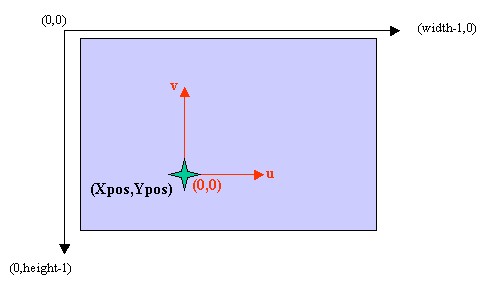 |
(u,v) is the bag axis system
(Xpos,Ypos) is the mouse position in screen coordinates The |
Here is the code of the ChangeBagPosition
method:
...
void CAACafViewerFeedbackManager::ChangeBagPosition(float Xpos, float Ypos)
{
CATSupport & Support = _pCurrentViewer->GetSupport();
float width, height, MMInSupportUnit, RatioWH ;
Support.GetWidthAndHeight(width,height);
MMInSupportUnit = Support.GetMMInSupportUnit();
RatioWH = Support.GetRatioWH();
CAT2DViewpoint & VP2D = _pCurrentViewer->GetMain2DViewpoint() ;
CATMathPoint2Df ModelPos;
VP2D.ComputeModelFromPixel( Xpos,Ypos,
ModelPos.x, ModelPos.y,
width, height,
MMInSupportUnit,
RatioWH);
CATMathVector2Df U,V ;
CAT3x3Matrix Matrix(U,V,ModelPos);
_pInformationsToDisplay->SetMatrix(Matrix);
}
}
...
|
(ModelPos.x, ModelPos.y) is the mouse position in model
coordinates. The ComputeModelFromPixel method transforms a 2D
point from screen coordinates to model coordinates.
Come back to the ViewerFeedbackCB method:
...
char MousePositionBuffer[200];
sprintf(MousePositionBuffer, "Mouse Coordinates : X=%d Y=%d", XPos, YPos);
CAT2DAnnotationTextRep * pMousePositionTextRep = NULL ;
pMousePositionTextRep = new CAT2DAnnotationTextRep( points,
MousePositionBuffer,
BASE_LEFT);
if (NULL != pMousePositionTextRep)
{
_pInformationsToDisplay->AddChild(*pMousePositionTextRep);
}
...
|
pMousePositionTextRep is a CAT2DAnnotationTextRep class
instance to display the mouse position screen coordinates.
Before to detail the code, a picture to explain the intersection point.
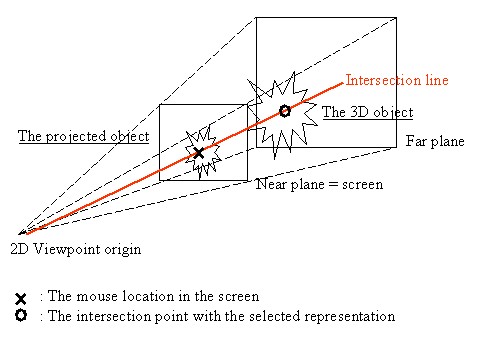 |
The point symbolized by a bold circle is the intersection point of the line and the nearest selected geometry. This point is in model coordinates. |
GetIntersection returns a CATGraphicElementIntersection
class instance pointer. This class contains as public data a CATMathPoint
. point is the intersection point. If there is nothing
under the mouse, GetIntersection returns NULL.
...
CATGraphicElementIntersection* pIntersection = pFeedbackEvent->GetIntersection();
if (NULL != pIntersection)
{
points[1] += 8.0f;
char IntersectionBuffer[200];
sprintf(IntersectionBuffer,
"Intersection Coordinates : X=%.2f Y=%.2f Z=%.2f",
pIntersection->point.GetX(),
pIntersection->point.GetY(),
pIntersection->point.GetZ());
CAT2DAnnotationTextRep * pIntersectionTextRep = NULL ;
pIntersectionTextRep = new CAT2DAnnotationTextRep( points,
IntersectionBuffer, BASE_LEFT);
if (NULL != pIntersectionTextRep)
{
_pInformationsToDisplay->AddChild(*pIntersectionTextRep);
}
pIntersection->Release();
pIntersection = NULL;
}
...
|
pMousePositionTextRep is a CAT2DAnnotationTextRep class
instance which contains the intersection point coordinates.
GetElementsUnder returns the list of elements under the
mouse. This list can be empty. The elements in this list are sorted, the first
(0 index) being the nearest, and the last ( n-1) the further. Each element is a
CATPathElement from the geometry to the root.
...
CATSO* SO = pFeedbackEvent->GetElementsUnder();
if (NULL != SO)
{
int SOSize = SO->GetSize() ;
for ( int i= 0 ; i < SOSize ; i++)
{
CATPathElement * pPathElement = (CATPathElement*) ((*SO)[i]) ;
CATUnicodeString PathElementName = "";
PathElementString(pPathElement,PathElementName);
char Buffer[200];
sprintf(Buffer, " : %d / %d", i+1,SO->GetSize());
CATUnicodeString Count(Buffer);
PathElementName.Append(Buffer) ;
points[1] += 8.0f;
CAT2DAnnotationTextRep* pElementTextRep = NULL ;
pElementTextRep = new CAT2DAnnotationTextRep( points,
PathElementName.CastToCharPtr(),
BASE_LEFT);
if (NULL != pElementTextRep)
{
_pInformationsToDisplay->AddChild(*pElementTextRep);
}
}
SO->Release();
SO = NULL;
...
|
This piece of code is a loop from the first element to the last. For each
path, PathElementString
converts a path in a string. This string is the input of a new CAT2DAnnotationTextRep
class instance.
[Top]
This use case explains how to receive information from a viewer when interactions occur. These information are inside a CATVisViewerFeebackEvent notification class.
[Top]
| Version: 1 [Aug 2003] | Document created |
| [Top] | |
Copyright © 2001, Dassault Systèmes. All rights reserved.